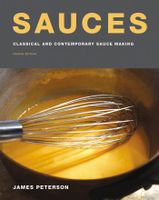Advertisement
The Relative Thickening Power of Liaisons
How to Read the Liaisons Chart
Appears in
Published 1991
The thickening power of liaisons is determined with a viscometer, which measures the resistance of a mixture to a rotating flat probe. The series of numbers running horizontally along the top of the following chart represents the viscosity—thickness—of various liquids, usually water or stock, thickened with starches, hydrocolloids, nuts, fats, or emulsifiers.
Zero represents no viscosity at all (apparently liquid helium gets close), while the number one represents the viscosity of water. The numbers increase exponentially and thus grow large very quickly. The chart is meant as a relative guide because it is best to get a sense of thickness based on those mixtures you already know—such as béchamel, hollandaise, mayonnaise, etc. For example, if you want to use sodium alginate as a thickener and for its emulsifying properties, the chart indicates that you will get the consistency of beurre blanc by using 1 percent (10 grams/liter) sodium alginate to water, broth, or other sauce.

